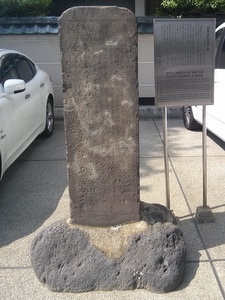Santo Kyoden

Santô Kyôden was an Edo period poet, writer, ukiyo-e artist, and tobacco purveyor[1] known primarily for his work on kibyôshi novels which he both wrote and illustrated himself.
Kyôden began studying under ukiyo-e artist Kitao Shigemasa from his early teens, and produced his first illustrated novels, and single-sheet prints, shortly afterward.
After graduating from Shigemasa's tutelage, Kyôden began working with the publisher Tsutaya Jûzaburô, who persuaded him to move away from prints and to devote himself more fully to book illustration. Though he often was both the author and illustrator of a given book, he often signed the illustrations as Kitao Masanobu, the author cited as Santô Kyôden.
Like many artists/writers of his time, Kyôden did not restrict his activities to only prints, or only to one form of writing. He was heavily involved in poetry circles and other cultural social circles, and is known not only for his ukiyo-e images and kibyôshi, but also for his calligraphy, for kyôka poetry, and a variety of other forms of creative production.
Following the publication of his work Tama Migaku Aoto ga Zeni in 1790, illustrated by Utamaro and published by Tsutaya Jûzaburô, Kyôden fell afoul of the authorities. Though the book was set in the Kamakura period and featured Hôjô Tokiyori as the chief character, the authorities recognized it as a parody of the policies of Matsudaira Sadanobu. Kyôden was handcuffed for fifty days, and Tsutaya had half his property confiscated.[2]
In 1793, when he was in his early thirties, he opened a tobacconist's shop in the Kyôbashi district of Edo[3]; he would often mention or depict his own shop in his writings and print designs. Kyôden is said to have devoted his days to the shop, and his nights to the pleasure districts. He bought out the contract of his favorite courtesan, Tama-no-i, in 1797, and took her as his second wife.[4]
He lived for a time within the Yoshiwara, marrying two shinzô[5] over the course of his life and becoming quite familiar (tsû) with the names and identities of the various courtesans and teahouses, and with the ways of the district[6], becoming a rather prominent personality within the Yoshiwara, and the Floating World of Edo more broadly. One of his wives took up work as a hairdresser, reportedly even purchasing or being granted a license to serve as the official barber for the neighborhood, serving as an official agent for the local neighborhood government.[7]
References
- Lane, Richard. Images from the Floating World. New York: Konecky & Konecky, 1978. pp128-129.
- ↑ Segawa Seigle, Cecilia. Yoshiwara: The Glittering World of the Japanese Courtesan. Honolulu: University of Hawaii Press, 1993. p141.
- ↑ Eiko Ikegami, Bonds of Civility, Cambridge University Press (2005), 319.
- ↑ Between Edo castle to the west and the Sumidagawa to the east, near where Tokyo Station stands today.
- ↑ Screech, Timon. "Tobacco in Edo Period Japan." in Gilman, Sander and Zhou Xun (eds.) Smoke: A Global History of Smoking. London: Reaktion Books, 2004. p98.
- ↑ Teenage attendants who had not yet become full-fledged courtesans, or those who wouldn't or couldn't become full-fledged courtesans on account of not possessing the beauty, wit, and/or various skills necessary.
- ↑ Seigle. p150.
- ↑ Tom Gaubatz, "A Barbershop on Every Corner: Urban Space and Identity Performance in the Fiction of Shikitei Sanba," guest lecture, UC Santa Barbara, 7 Jan 2016.